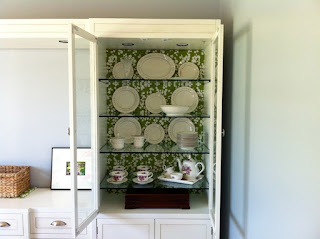I've noticed that the more you stare at something, the more you get used to how it looks in a space. You almost stop seeing it and you lose sight of what it could be. So at first, I thought about leaving the cabinets mirrors as is. I thought if we updated the glass doors and all the hardware, maybe that would be enough. I'm all about starting small and taking things one small project at a time.
But after many more nights of sitting and staring at those 1980s mirrors, I decided it was a cheap and easy update and if I didn't like it, it was easy to remove. So I went for it and I love how it turned out.
Here's how I did it:
Materials:
Foam core board (enough to cover the entire area in one piece. Available at craft stores. If they don't have it large enough on the shelf, ask in the frame department. They carry larger pieces for about $10 each)
Fabric (enough to cover the area with no seams and enough to cover the foam core with at least four inches of overlap on each side. My fabric was 54 inches wide so I only needed two yards.)
Spray adhesive
Glue dots or Zots
Tools:
Rotary cutter
Cutting mat
Yardstick and measuring tape
Cost: About $40 - $20 for foam core, $12 for fabric, $8 for adhesives
Time: 2-3 hours
Step 1: Take precise measurements of the back of your cabinet. Mark out these measurements on the foam core. I made marks on a yardstick to help ensure an accurate transfer to the foam core.
Note: I was fortunate that my shelves were removable, meaning I could use one continuous piece for the entire cabinet. If your shelves are fixed or attached to the back wall, you may need to do multiple pieces.
Step 2: Use the rotary cutter to cut the foam core board down to size. I used a yardstick to ensure a straight cut. Be sure to place the cutting mat underneath the board to prevent scratching the surface underneath.
Once the board is cut, it may help to place it in the cabinet to ensure a snug fit. Remember that it's always easier to cut smaller if needed than to wish you had more!
Step 4: Working one edge at a time, spray the edge of the foam core with spray adhesive and fold the fabric over on to the foam core, being sure to keep the fabric straight and tight.
Step 5: Fold the corners over like if you were wrapping a package. Use a glue dot to secure the corners.
Step 6: Continue working your way around until all the excess fabric is wrapped around the back of the foam core and glued in place. Use glue dots as needed to ensure the fabric is securely attached to the back of the board.
Note: I thought about using spray adhesive on the front of the board to secure the fabric in place. The fabric that I bought, however, was very thin, and the glue soaked through and left a mark. So, if you want to go this route, be sure to test an area first to ensure it won't stain.
Step 7: Once the glue has dried, place the board in the cabinet. If your measurements were close enough, it should fit snugly without any adhesive. If things are a little loose, you could use a removable glue dot in each corner to secure things in place. Once you put the shelves in, that may also help hold things in place.
Step 8: Stand back and enjoy your work!
The neat thing about this project is you can easily swap out the fabric depending on the season, your decor or your mood. Unlike paint or wallpaper, there is very little commitment. Just pull the foam core out and re-wrap with whatever fabric you'd like.
Here's how it looked before we painted...
And here it is now, with gleaming china in place. Love it!
















Looks brill thanks!
ReplyDeleteLooks brill thanks!
ReplyDelete